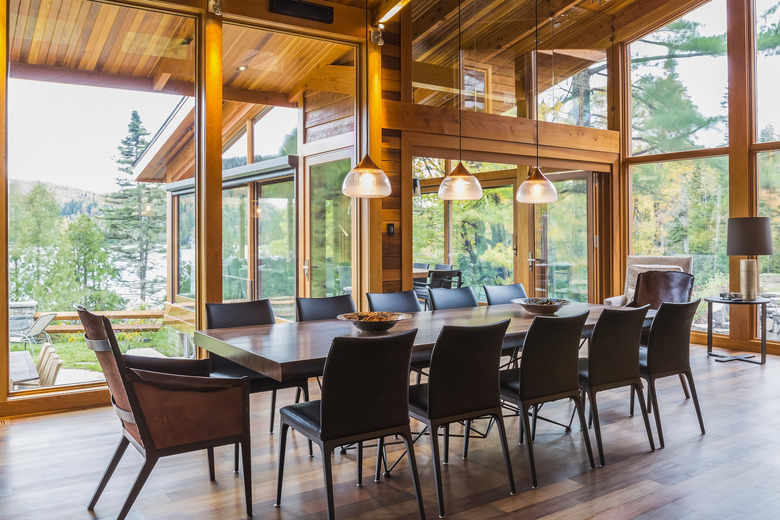Can You Put Knotty Cedar Planking Down For Flooring?
We may receive a commission on purchases made from links.
Knotty cedar wood flooring has a rustic and inviting appeal, and it smells good too. Commonly used for furniture, its popularity as a flooring material has increased in recent years. Cedar is a softwood, so it may not withstand as much wear as hardwoods. Still, knotty cedar flooring has pros and cons to consider before you reach the point of choosing a hue for your home's floors.
Tip
Knotty cedar planking is good for flooring as long as you care for it properly.
Pros of Cedar Flooring
Pros of Cedar Flooring
There are many good things about cedar flooring, from the cost to its relative eco-friendliness.
- It's more affordable than some other woods: As a softwood, cedar tends to be cheaper than hardwoods, such as oak or hickory. Depending on where you live and what's available, cedar could be less than half the cost of hardwoods.
- It's easy to install: Because of its pliability and flexibility, cedar floors are generally easier to install than hardwood floors.
- It comes in a variety of colors: Different varieties of cedar range in color from warm red to cool white. Whatever your preferences and color scheme, you're likely to be able to find a cedar hue to match.
- Many people like its character: As well as the color, cedar planks display an attractive array of knots, pinholes, and prominent grain. The wood comes in different grades so you can choose the level of character that you prefer.
- It's easy to repair: Although cedar can be damaged more easily than hardwoods, it can also be repaired more easily. There's a limit to the number of times hardwood floors can be sanded down and refreshed, but cedar is less dense, so it can be fixed up and made to look new again.
- It's relatively eco-friendly: If environmental sustainability is a priority, cedar and most softwoods are fast-growing woods. This makes cedar more environmentally friendly to grow and harvest than slow-growing hardwoods.
- It muffles sound: Because of its softness and springiness, cedar floors have a sound-dampening or muffling effect. This means that if you're in a downstairs room and someone above is walking on a cedar floor, you're less likely to be disturbed by the tap-tap of footsteps than with hardwood floors.
Cons of Cedar Flooring
Cons of Cedar Flooring
As well as many pros, there are a few drawbacks to using cedar for flooring.
- It's less durable than some other woods: Cedar is a softwood, so it's best avoided in high-traffic areas, like hallways or entryways. It will show wear and tear more quickly than hardwood floors.
- It usually comes unfinished: Cedar in plank form rarely comes with a durable stain and topcoat — that is, prefinished. The sanding and finishing must be done after the floor has been laid, which can increase the time and cost of the project.
- It's less resistant to pests: Cedar isn't only attractive to humans; it can be attractive to bugs too. Furniture beetles are attracted to the outer layers of wood, or sapwood, so opt for planks made with heartwood (the inner layers) or planks that have been pretreated to repel pests.
Best Rooms for Cedar Flooring
Best Rooms for Cedar Flooring
Cedar floors are best avoided in high-traffic areas, but if you're attracted to them, there's no reason to avoid them. Consider adding cedar floors to adult bedrooms, home offices, studies, library nooks, and walk-in closets. If you're seeking a bit more luxury and pampering, why not install a cedar sauna at home? Cedar is the most traditionally used wood for Scandinavian saunas.
Maintaining Cedar Floors
Maintaining Cedar Floors
Cedar floors will likely show wear and tear faster than hardwoods, but with good maintenance, you can keep them looking good.
To bring out the wood's natural hue, a clear varnish will prevent it from darkening over time with the typical wear and tear floors receive. Cedar plank flooring will need some work over the years to maintain its original color or close to it. It can also warm up and change patina over the years, adding to its appeal.
As with all wooden floors, prevent damage from small stones or other debris that shoes bring into the house by regularly sweeping and dusting the floors.
